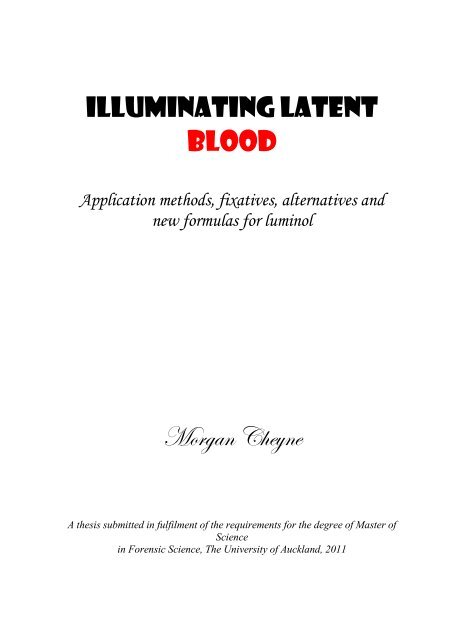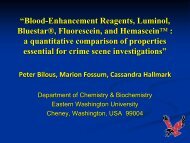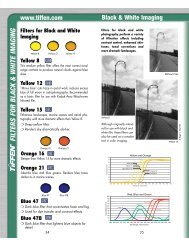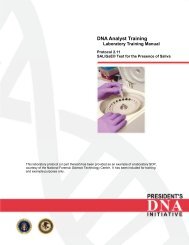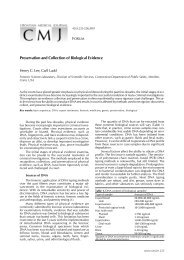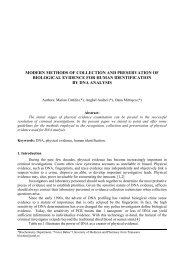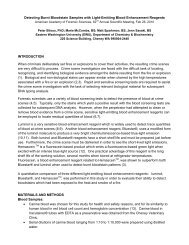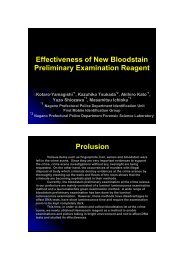Illuminating Latent Blood - Abacus Diagnostics, Inc.
Illuminating Latent Blood - Abacus Diagnostics, Inc.
Illuminating Latent Blood - Abacus Diagnostics, Inc.
You also want an ePaper? Increase the reach of your titles
YUMPU automatically turns print PDFs into web optimized ePapers that Google loves.
<strong>Illuminating</strong> <strong>Latent</strong><br />
<strong>Blood</strong><br />
Application methods, fixatives, alternatives and<br />
new formulas for luminol<br />
Morgan Cheyne<br />
A thesis submitted in fulfilment of the requirements for the degree of Master of<br />
Science<br />
in Forensic Science, The University of Auckland, 2011
Abstract<br />
________________________________________________________<br />
Luminol is an effective chemical reagent for the detection and enhancement of latent blood<br />
and is widely utilised for this purpose throughout the forensic community. It is characterised<br />
by a pale blue chemiluminescent light which is emitted upon reaction of luminol with blood.<br />
Many improvements to the luminol formula have been attempted over the years. In this<br />
thesis I critically evaluated three new luminol based formulas, one commonly used luminol<br />
formula and an alternative to luminol, fluorescein. These reagents were compared and<br />
contrasted in terms of sensitivity, longevity of reaction and DNA preservation as well as<br />
economic and practical considerations.<br />
<strong>Blood</strong> pattern distortion and destruction is a major disadvantage to using luminol at crime<br />
scnenes. Five spray types and five fixatives/ shear thinning agents were evaluated on their<br />
ability to preserve the spatial morphology of bloodstain patterns on non-porous surfaces.<br />
Lumiscene Ultra showed the highest intensity of emitted light for higher concentrations of<br />
blood. However, when blood was diluted to lower concentrations, this intensity was<br />
comparable to Bluestar Magnum, Lumiscene and Hemascein blood detecting reagents. All of<br />
the aforementioned reagents, however, had a greater sensitivity than the Grodsky formula.<br />
Hemascein had the longest reaction time with Lumiscene Ultra and Grodsky having the<br />
longest reaction times for the luminol based reagents. All of the reagents showed a certain<br />
amount of DNA degradation when compared to a water control sample. Hemascein<br />
preserved DNA to a greater extent than the rest of the reagents. Lumiscene significantly<br />
decreased the success of DNA profiling success.<br />
The ECO spray and spray gun were found to be the best application methods for luminol for<br />
the purpose of preserving the morphology of blood patterns. The hand pump sprayer<br />
severely affected the preservation of blood patterns.<br />
The combination of a zinc fixative, a shear thinning agent called ABA fix and the ECO spray<br />
was found to be best at fixing and preserving the morphology and spatial position of blood<br />
patterns.<br />
3
LOD 5 AU 10 4-4.5 4.5-5 - -<br />
Table 4.6: Shows the limit of detection for each of the reagents at 10 and 5 intensity units.<br />
From the above table it can be seen that Bluestar Magnum has the shortest reaction<br />
length. Lumiscene had a slightly greater LOD than Bluestar Magnum at both 5 and<br />
10 arbitrary units. Grodsky had a longer significantly longer reaction length than<br />
Bluestar Magnum and Lumiscene. Lumiscene Ultra, contrary to the images,<br />
appeared not to have a limit of detection as the intensity of the reaction at 20<br />
minutes was greater than 10. Hemascein also had an intensity value greater than<br />
10 after 20 minutes with an intensity value considerably greater than that of<br />
Lumiscene Ultra.<br />
4.3 DNA and mRNA Analysis<br />
4.3.1 DNA Quantitation<br />
DNA Quantitation was important in this study, first to determine the amount of<br />
human DNA present to determine the amount of DNA solution that should be added<br />
to the PCR tube for STR amplification. The Identifiler PCR amplification kit<br />
requires a final input DNA concentration of 0.05-0.125ng/µl. If the input DNA is less<br />
or more than this range then STR profiling will be impaired (AmpFLSTR®<br />
Identifiler® User‘s Manual.<br />
Also, DNA quantification is important to determine whether there are inhibitors<br />
present which could inhibit the PCR reaction. The Quantifiler kit contains an<br />
internal PCR control (IPC) sequence which is co-amplified with the sample. The IPC<br />
is a synthetic oligonucleotide sequence which produces fluorescence which is<br />
detected by the quantification system. The IPC is useful for determining whether the<br />
DNA present in the sample is unsuitable for amplification by PCR by predicting the<br />
presence of PCR inhibitors. If PCR inhibitors are present the IPC is either not<br />
amplified or is amplified with a high Ct value. If there is no human DNA present, or<br />
the DNA is degraded, the IPC is still amplified. (M. Barbisin et al Validation of a<br />
multiplexed system for quantification of Human DNA and human male DNA and<br />
detection of PCR inhibitors in biological samples (2007) Proceedings of the 18 th<br />
125


